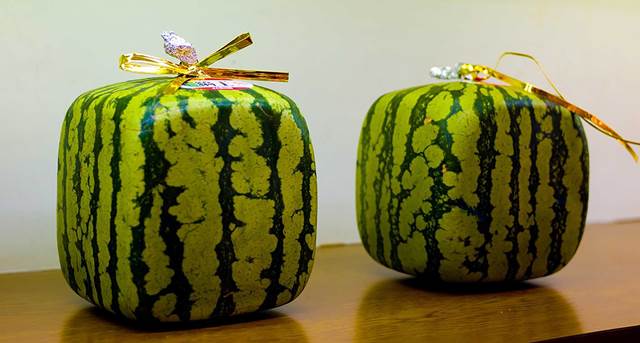The summer season is associated with fresh vegetables and berries in people. But experienced gardeners and gardeners were interested in tests conducted in Japan more than 20 years ago. These figures brought watermelons of interesting shape - square. And this is not only decor, but quite edible berry, which brings considerable income. How to do and how to grow such fruits talk in this article.
Table of contents
The origin of square berries
For the first time the secret of Japanese agrarians was solved by Oktyabrina Ganichkina, which had the status of candidate of agricultural sciences and the author of books on gardening and horticulture. She believes that the Japanese were trying to solve the problems of transportation, but the results exceeded all the results and prosperous citizens were interested in square berries.
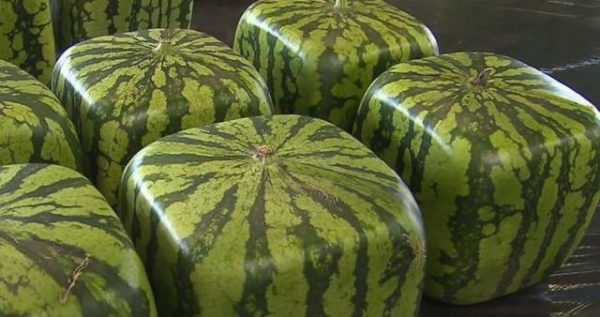
It turned out that such a product is easier to stack, store and transport, as well as to transport in large volumes. A high demand for goods inspired farmers to further discoveries. And soon the light saw square melons and tomatoes.
Why and who need square watermelons?
All farmers and industrialists immediately appreciated the value of the discovery.
First is convenience and efficiency of transportationas well as storage. Secondly, this fruit is conveniently placed on a plate and cut into standard neat slices.
Third, prices are significantly higher than standard round or oval watermelons.Therefore, the secrets of growing such watermelons began to leak and spread throughout the world.
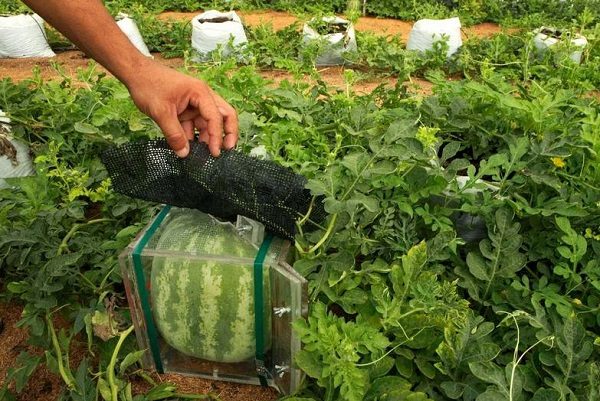
Advantages and disadvantages
The internal contents of the watermelon is no different than the mouth of the berries of a standard form. True, they can yield to taste standards. But such berries have a number of distinctive features:
- convenient to store and transport, minimizing transportation costs;
- conveniently placed on the dining table and in the refrigerator;
- square shape facilitates neat cutting;
- high cost in the market.
But the transformation affected only the external forms of the berries and the taste characteristics did not affect. For inexperienced farmers, berries ripen unevenly or do not have time to ripen., therefore, by sweetness and richness of taste, they are inferior to their oval counterparts.
These two factors can be safely attributed to the minuses, which prevent the launch of the process of large-scale production and oust the watermelons of the usual form.
Features of growing
Growing will give a positive result only in the southern regions with a stable warm climate. To implement the plan you will need to choose the right type of watermelon. It is better to give preference to hybrids with a short growing season.
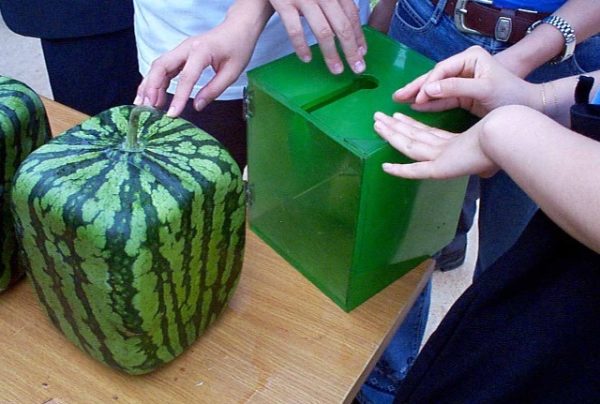
All activities should be divided into stages.
- Sowing seeds. The best time for planting will be the end of spring. Otherwise, the fruits will not have time to ripen. You need to germinate seeds in wet ground or sand with good lighting.
- Planting in open ground should be carried out when the threat of return frost has passed, and the soil warms up to 15 degrees.
- After planting watermelons should provide standard care., which consists in regular watering, loosening the soil and cleaning of weeds.
- Fetus formation. When the watermelon ovary reaches the size of an average apple, it is placed in special cubic shapes. Fruits are placed so that all the bands are arranged vertically. Further care is no different from the usual. Just need to regularly air the form and cover them in extreme heat. When the berries grow and no longer fit in the houses,then the forms can be removed and the watermelons can be checked for ripeness.
Watermelon seeds will sprout a week and a half after they are placed in a comfortable environment. To increase the germination of seed, it is recommended to place it in water heated to 50 degrees for 10-15 minutes.
Before the emergence of seedlings, seedling tanks should be kept at room temperature, and with the appearance of seedlings, move to a cooler place where the air temperature will not exceed 17 degrees.
Making a square shape with your own hands
For the manufacture of forms requires the presence of a number of materials and tools.
- Durable sheets of transparent material with a thickness of 0.5 - 0.8 mm (plastic, polycarbonate or glass).
- Screws with nuts and corners for fastening walls.
- Furniture hinges to ensure the mobility of the cover.
- Hacksaws or jigsaw.
- Drills, screwdrivers, rulers and marker.
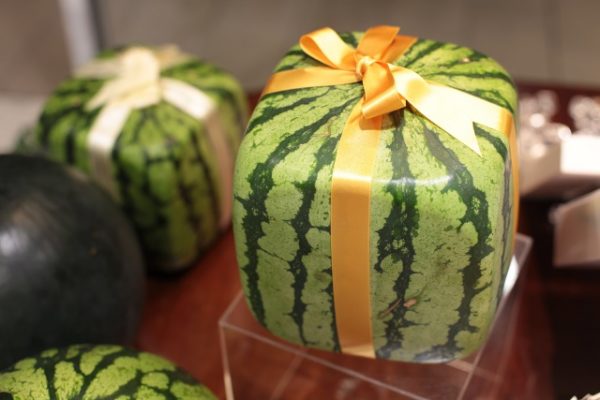
When all the tools and materials are prepared, you can begin the process of assembling the form for watermelons.
- From sheets of transparent material cut into squares measuring 20x20 cm.
- Fasten billets with screws, forming a square.
- On the one hand to make a hole for the vine.
- Fix the top (cover) to the hinges.
The finished form is reliable and durable and is able to withstand the onslaught of a growing berry, forcing it to take the desired shape.
Harvesting and Storage
Watermelons should be removed from the vine in the first stage of removable maturity., because the fully ripened berries are not intended for long-term storage. Unripe fruits will not be stored either, because they cannot reach the harvest after harvesting.

Determine the degree of ripeness of watermelons can be on the pink color of the pulp and the dark color of the seeds. Ho There are several ways to determine the maturity of watermelons “on the vine”:
- by skin color - when ripe, it becomes shiny, gaining gloss;
- by peel strength - if the watermelon crust is hard and cannot be pushed by pressing a finger, this indicates the removable ripeness of the striped berry;
- on the stemwhich dries out when ripe berries and suggests that watermelon accumulate all the necessary nutrients;
- by pressure sore - it is formed in the place of contact of the berries with the ground and has a yellow color;
- by sound - when rapping, ripe watermelons make a pronounced muffled sound.
For long-term storage, late-ripening watermelons with thick skin and genetic damage resistance are suitable. Such fruits are removed from the vine with a pruner or knife, leaving the stem at least 5 cm long.
For storage lay only healthy watermelons, without mechanical damage. Lay the fruit should be on the shelves with a soft straw bedding. During storage, you should regularly inspect watermelons and remove spoiled ones.
Square watermelons can be stored in earthen trenches. At the same time, each layer needs to be restyled with straw or chips, and from above pour a layer of soil, at least 35 cm thick.
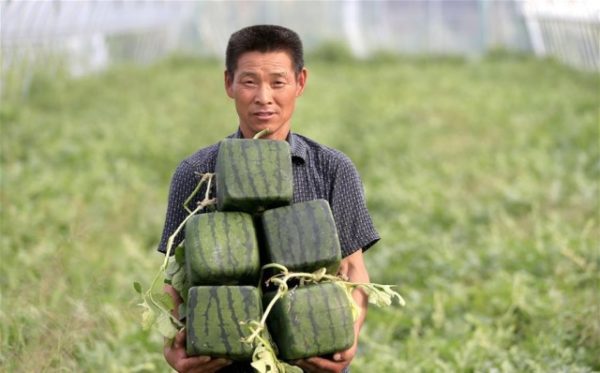
With any method of storage watermelons should not be supercooling - this will lead to damage to the pulp, loss of taste and damage to fruits.
How much does a square watermelon cost?
Growing square watermelons with your own hands is troublesome, but profitable. How much does one berry cost? The cost of one fruit on the market often reaches twenty thousand rubles.But not all stores in Russia are ready to sell these products. After all, they are much inferior in taste to standard berries and they are best used as an entourage at holidays and celebrations.
